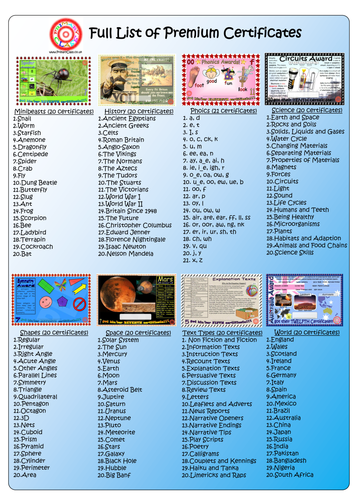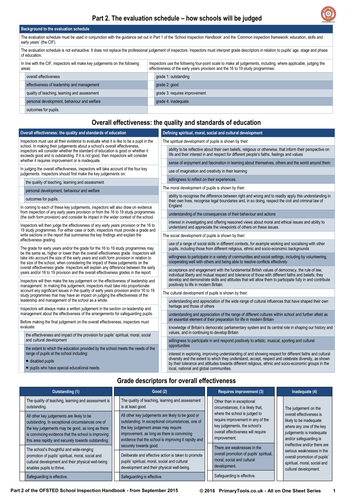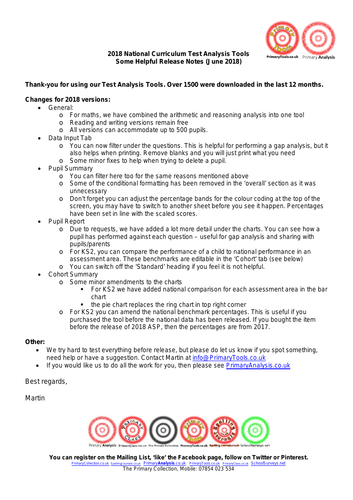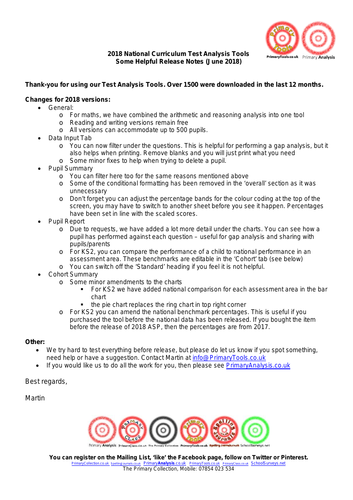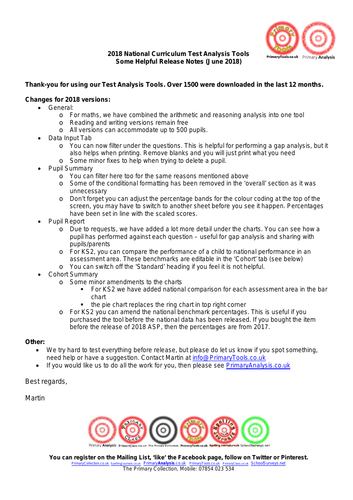
284Uploads
2076k+Views
2041k+Downloads
Whole school

20x Science Topic Themed Reward Certificates
These beautiful, individual, rewarding and educational certificates are perfect as class or school rewards. Each pack is based on an area of the National Curriculum and has the following features:
20 individual certificates per pack
A tracking sheet for a class
Pictures, text and diagrams to help explain the theme of the certificate
A space for the pupil's name
A5 size (2 per A4 sheet for self printed version)

2016 KS1 Mathematics Test Analysis Tools
Produces easy on the eye tables and charts for cohorts and individuals. Broken down into areas of learning and specific question performance.
Arithmetic Analysis: up to 250 pupils
Reasoning Analysis: up to 1,000 pupils. Includes individual pupil reporting
Works best in Excel 2010 or later with macros enabled

2016 KS1 Grammar, Punctuation and Spelling Test Analysis Tools
Produces easy on the eye tables and charts for cohorts and individuals. Broken down into areas of learning and specific question performance. For up to 550 pupils.
Works best in Excel 2010 or later with macros enabled

All on One A4 Sheet: OFSTED Inspection Handbook Part 2 (from September 2015)
All on one A4 Sheet:
OFSTED Inspection Handbook Part 2: The evaluation schedule – how schools will be judged (from September 2015)
Sample found here: https://www.tes.com/teaching-resource/all-on-one-a4-sheet-part-2-of-the-ofsted-inspection-handbook-from-september-2015-11186257
Includes judgement guidance and grade descriptors for each of the following sections, each on one A4 sheet:
Overall Effectiveness;
Effectiveness od Leadership and Management;
Quality of Teaching, Learning and Assessment;
Personal Development, Behaviour and Welfare;
Outcomes for Pupils;
Effectiveness of the Early Years Provision;
Effectiveness of the 16 to 19 Study Programmes.
(NB: Footnotes not included)

2016 KS2 Mathematics Test Electronic Analysis
Produces easy on the eye tables and charts for cohorts and individuals. Broken down into areas of learning and specific question performance.
Paper 1 Arithmetic (up to 250 pupils)
Papers 2 & 3 Reasoning: Up to 1000 pupils with individual pupil reporting (works best in Excel 2010 or later with macros enabled)
Full free 2016 KS2 Reading Analysis Tool available here:
https://www.tes.com/teaching-resource/2016-ks2-test-electronic-analysis-for-reading-11291700
Grammar, Punctuation and Spelling Version also available:
https://www.tes.com/teaching-resource/2016-ks2-grammar-punctuation-and-spelling-test-electronic-analysis-11291706

2016 KS2 Grammar, Punctuation and Spelling Test Electronic Analysis
Produces easy on the eye tables and charts for cohorts and individuals. Broken down into areas of learning and specific question performance.
Electronic Analysis with individual pupil reporting for up to 550 pupils
(works best in Excel 2010 or later with macros enabled)
Full free 2016 KS2 Reading Analysis Tool available here:
https://www.tes.com/teaching-resource/2016-ks2-test-electronic-analysis-for-reading-11291700
2016 Mathematics Version also available:
https://www.tes.com/teaching-resource/2016-ks2-test-electronic-analysis-for-mathematics-11291695

2017 KS1 National Curriculum Test for Mathematics (Arithmetic and Reasoning) Electronic Analysis
Works best in Excel 2010 or later with macros enabled
New features for the 2017 version include Age Related Expectations reporting and improved presentation of graphs

2017 KS1 National Curriculum Test for Grammar, Punctuation and Spelling Electronic Analysis
Works best in Excel 2010 or later with macros enabled
New features for the 2017 version include Age Related Expectations reporting and improved presentation of graphs

2016 - 2017 School Assembly Year Planner (Updated Jan 17)
Covers approximately 270 events and the full 12 months of the academic year including...
Approximately 30 new events added to the new 2016/17 Version
Colour coded dates for awareness days/weeks/months
Key historical dates
Key religious dates
Key assessments dates (SATS, Phonics)
National holidays and more
Each event carries a link to more information
Excellent for planning assemblies
15/16 Version used in over 190 schools
Designed to be printed across two A3 sheets, although also prints well in A4

2022 Phonics Check Question Level Analysis
Summary of Features:
Pupil Summary shows total marks for each paper, number of questions unanswered, number of incorrect answers, total overall score (and percent), total score in each focus area. Option to adjust the colour thresholds to make it easier to spot patterns and gaps.
Pupil Reports show a summary of performance in each focus area for an individual pupil. Useful for feeding back to pupils, parents and informing intervention teachers.
Cohort Summary shows an overview of the cohort against each focus area. This page gives a summary of attainment including number and percent meeting the expected standard.
Other Charts Charts which show performance for each question, organised by most correct to incorrect and by word type.
Requires Excel with macros enabled.

2017 KS2 National Curriculum Test for Grammar, Punctuation and Spelling Electronic Analysis
With individual pupil reporting for up to 550 pupils
Works best in Excel 2010 or later with macros enabled
New features for the 2017 version include Age Related Expectations reporting and improved presentation of graphs

2023 KS1 SATs Grammar, Punctuation and Spelling Test and Question Level Analysis
2023 KS1 Grammar, Punctuation and Spelling Test and Question Level Analysis
Requires Excel with macros enabled.
Summary of Features (please note some features may not be available depending on the test type):
Pupil Summary shows total marks for each paper, number of questions unanswered (possibly indicating need to increase pace), number of incorrect answers, total overall score (and percent), total score in each strand. Option to adjust the colour thresholds to make it easier to spot patterns and gaps.
Pupil Reports show a summary of performance in each strand for an individual pupils. Useful for feeding back to pupils, parents and informing intervention teachers.
Contextual Analysis shows a breakdown by key groups (gender, SEND status, disadvantaged, EAL) plus up to four custom groups. Compares school data (grades and scaled scores) to national data in a detailed but user-friendly report.
Cohort Summary shows an overview of the cohort against each strand. This is also compared to national data where it is available. This page gives a summary of attainment including number and percent at expected and higher standard.
Strand Summary shows a the weighting of each strand and the performance within it. For example, in a grammar test a cohort may perform poorly in identifying sentence types and equally poorly in identifying punctuation. However as there is more weighting given to punctuation, it would be advisable to focus on this area.
Other Charts Charts which show performance for each question, organised by most correct to incorrect, by strand and also by year group question (for mathematics). The most powerful chart orders questions from most correct to incorrect enabling you to see precisely where there are strengths and weaknesses.

2018 KS1 National Curriculum (SATs) Test Analysis for Mathematics
2018 KS1 National Curriculum (SATs) Test Analysis for Mathematics.
Please see release notes for new features.
Analysis for all tests is available elsewhere on TES or from our website.

2018 KS1 National Curriculum (SATs) Test Analysis for Grammar, Punctuation and Spelling.
2018 KS1 National Curriculum (SATs) Test Analysis for Grammar, Punctuation and Spelling.
Please see release notes for new features.
Analysis for all tests is available elsewhere on TES or from our website.

2022 KS1 SATs Grammar, Punctuation and Spelling Test and Question Level Analysis
2022 KS1 Grammar, Punctuation and Spelling Test and Question Level Analysis
Requires Excel with macros enabled.
Summary of Features (please note some features may not be available depending on the test type):
Pupil Summary shows total marks for each paper, number of questions unanswered (possibly indicating need to increase pace), number of incorrect answers, total overall score (and percent), total score in each strand. Option to adjust the colour thresholds to make it easier to spot patterns and gaps.
Pupil Reports show a summary of performance in each strand and per question for an individual pupils. Useful for feeding back to pupils, parents and informing intervention teachers.
Contextual Analysis shows a breakdown by key groups (gender, SEND status, disadvantaged, EAL) plus up to four custom groups. Compares school data (grades and scaled scores) to national data in a detailed but user-friendly report.
Cohort Summary shows an overview of the cohort against each strand. This is also compared to national data where it is available. This page gives a summary of attainment including number and percent at expected and higher standard.
Strand Summary shows a the weighting of each strand and the performance within it. For example, in a grammar test a cohort may perform poorly in identifying sentence types and equally poorly in identifying punctuation. However as there is more weighting given to punctuation, it would be advisable to focus on this area.
Other Charts Charts which show performance for each question, organised by most correct to incorrect, by strand and also by year group question (for mathematics). The most powerful chart orders questions from most correct to incorrect enabling you to see precisely where there are strengths and weaknesses.

2019 KS1 Mathematics Question Level Analysis
Summary of Features (please note some features may not be available depending on the test type):
Pupil Summary shows total marks for each paper, number of questions unanswered (possibly indicating need to increase pace), number of incorrect answers, total overall score (and percent), total score in each strand. Option to adjust the colour thresholds to make it easier to spot patterns and gaps.
Pupil Reports show a summary of performance in each strand for an individual pupils. Available in 2017 versions and later excluding reading. 2018 versions and later contain detailed feedback on each question. Useful for feeding back to pupils, parents and informing intervention teachers.
Cohort Summary shows an overview of the cohort against each strand. This is also compared to national data where it is available. This page gives a summary of attainment including number and percent at expected and higher standard.
Strand Summary shows a the weighting of each strand and the performance within it. For example, in a grammar test a cohort may perform poorly in identifying sentence types and equally poorly in identifying punctuation. However as there is more weighting given to punctuation, it would be advisable to focus on this area.
Other Charts Charts which show performance for each question, organised by most correct to incorrect, by strand and also by year group question (for mathematics). The most powerful chart orders questions from most correct to incorrect enabling you to see precisely where there are strengths and weaknesses.

2019 KS1 Grammar, Punctuation & Spelling Test and Question Level Analysis
Summary of Features (please note some features may not be available depending on the test type):
Pupil Summary shows total marks for each paper, number of questions unanswered (possibly indicating need to increase pace), number of incorrect answers, total overall score (and percent), total score in each strand. Option to adjust the colour thresholds to make it easier to spot patterns and gaps.
Pupil Reports show a summary of performance in each strand for an individual pupils. Available in 2017 versions and later excluding reading. 2018 versions and later contain detailed feedback on each question. Useful for feeding back to pupils, parents and informing intervention teachers.
Cohort Summary shows an overview of the cohort against each strand. This is also compared to national data where it is available. This page gives a summary of attainment including number and percent at expected and higher standard.
Strand Summary shows a the weighting of each strand and the performance within it. For example, in a grammar test a cohort may perform poorly in identifying sentence types and equally poorly in identifying punctuation. However as there is more weighting given to punctuation, it would be advisable to focus on this area.
Other Charts Charts which show performance for each question, organised by most correct to incorrect, by strand and also by year group question (for mathematics). The most powerful chart orders questions from most correct to incorrect enabling you to see precisely where there are strengths and weaknesses.

2017 KS2 National Curriculum Test for Mathematics Electronic Analysis
New features for the 2017 version include Age Related Expectations reporting and improved presentation of graphs.
Paper 1 Arithmetic (up to 250 pupils)
Papers 2 & 3 Reasoning: Up to 1000 pupils with individual pupil reporting
Works best in Excel 2010 or later with macros enabled

2018 KS2 National Curriculum (SATs) Test Analysis for Grammar, Punctuation and Spelling
2018 KS2 National Curriculum (SATs) Test Analysis for Grammar, Punctuation and Spelling.
Please see release notes for new features.
Analysis for all tests is available elsewhere on TES or from our website.

2024 KS1 Mathematics Question Level Analysis
2024 KS1 Mathematics Question Level Analysis
Requires Excel with macros enabled.
Instant download after purchase. Maximum of 5 downloads.
Please note sample pictures are for the KS2 Mathematics Analysis.
Summary of Features (please note some features may not be available depending on the test type):
Pupil Summary shows total marks for each paper, number of questions unanswered (possibly indicating need to increase pace), number of incorrect answers, total overall score (and percent), total score in each strand. Option to adjust the colour thresholds to make it easier to spot patterns and gaps.
Pupil Reports show a summary of performance in each strand for an individual pupils. Available in 2016 versions and later. Useful for feeding back to pupils, parents and informing intervention teachers.
Contextual Analysis (2019 versions onwards) shows a breakdown by key groups (gender, SEND status, disadvantaged, EAL) plus up to four custom groups. Compares school data (grades and scaled scores) to national data in a detailed but user-friendly report.
Cohort Summary shows an overview of the cohort against each strand. This is also compared to national data where it is available. This page gives a summary of attainment including number and percent at expected and higher standard.
Strand Summary shows a the weighting of each strand and the performance within it. For example, in a grammar test a cohort may perform poorly in identifying sentence types and equally poorly in identifying punctuation. However as there is more weighting given to punctuation, it would be advisable to focus on this area.
Other Charts Charts which show performance for each question, organised by most correct to incorrect, by strand and also by year group question (for mathematics). The most powerful chart orders questions from most correct to incorrect enabling you to see precisely where there are strengths and weaknesses.
2024 KS1 Mathematics Question Level Analysis (SATs)

